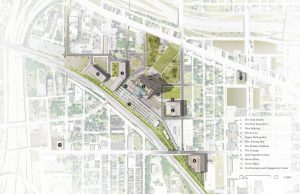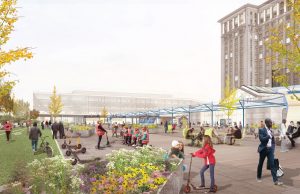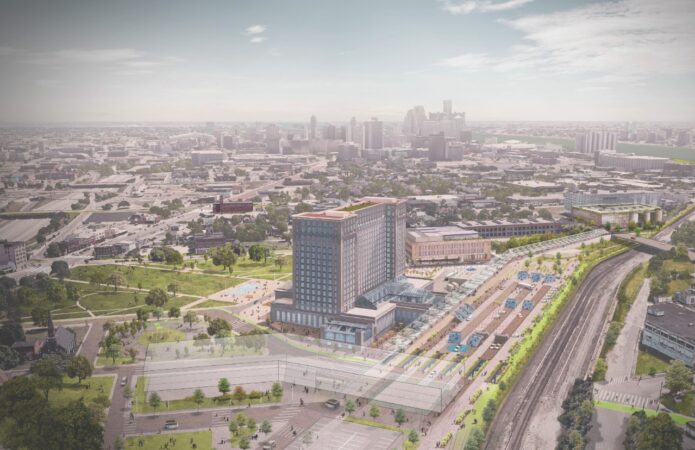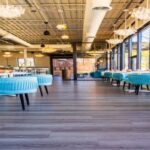On November 17, 2020, Ford Motor Company formally revealed its plans for its Mobility Innovation District situated around Michigan Central Station in Corktown. Building on inclusivity, vibrant green walking spaces and community connection, Ford aims to transform the former train station and its surrounding buildings into a one of a kind center for innovation.
Imagining a new transportation operating system is one goal for Ford after the project is finished. Still, to do so, Michigan Central Station will need to be redesigned, having been shuttered since 1988. With phase two of Michigan Central Station restoration well underway, work has been smooth amid the ongoing pandemic and Ford still aims to complete the project by the end of 2022.
MICHIGAN CENTRAL COMBINES PAST, PRESENT, AND FUTURE

MICHIGAN CENTRAL SITE PLAN – COURTESY OF PRACTICE FOR ARCHITECTURE AND URBANISM (PAU)
Comprising 18 floors if you include the basement, Michigan Central Station is just one part of the larger 30-acre site plan, developed by lead architect and strategic planner Practice for Architecture and Urbanism. Designed as a walkable community plan, the district will prioritize the needs of community members and businesses in the region while connecting the Corktown neighborhood with the surrounding region.
Aiming to preserve Corktown’s history while blending in aspects of modern design, the two factors will merge with future ideas that come out of the innovation hub. The project also aims to work as a gateway for the North Corktown, Mexicantown, and Hubbard Richard neighborhoods, utilizing new mobility solutions to connect the areas with downtown, the riverfront, and more.
In speaking with the Detroiters through a community-based 18-month research project, Ford and the team behind Michigan Central have created a plan tailored around community needs. Street art, public plazas, and walkways were just a few solutions found when engaging with the public, ideas that will utilize local artists and talent for the finished project.
“Few works of architecture better embody the past, present, and future of Detroit like Michigan Central Station. This plan – led by Ford and forged in collaboration with local stakeholders – provides a vision for how the reimagined station, with the public spaces and buildings that surround it, can together become a unique and authentic destination for community members, innovators and visitors alike,” said Vishaan Chakrabarti, founder and creative director of Practice for Architecture and Urbanism, in a press release put out by Ford.
Over time, I am confident that this project will become a global model for how to grow and build our cities while celebrating the narratives and structures that define our past.
In total, the mobility innovation district includes Michigan Central Station, the Book Depository, a new construction project named Building West, and The Factory, an already existing building currently home to 250 members of Ford’s autonomous vehicle business unit.
REIMAGINING MOBILITY AND TRANSPORTATION SYSTEMS
Creating a connected, walkable, inclusive district requires filling in multiple mobility gaps, something that can be accomplished by utilizing current mobility solutions while at the same time imagining solutions of the future.

BAGLEY PARKING HUB – COURTESY OF ROSSETTI
When reimagining transportation solutions and working to create a better transportation operating system, Carolina Pluszczynski, Michigan Central Development Director, describes the process as having multiple levels.
“When you think about the different layers of that, what you need underneath to enable it are the things at the street level, the new innovations that we need to be testing in the way people move, “Shared Pluszczynski. “So I think about it in terms of levels, if you think about underneath on top of the terrain, all the way up to the sky, and you think about that smart world technology, that to me is how we think about the transportation operating system.”
This idea of levels comes into play throughout the design of the district. Existing mobility solutions such as scooters and bikes connect drivers to parking garages and buildings. Simultaneously, Ford and other partners within the complex will be imagining the next steps ahead to improve the process further.
In our Bagley parking garage area, you have to park your car and then get somewhere, so that is a place where we can put hubs and we can have the bikes available, we can have scooters available, and then work with some of these companies to identify if there are any new form factors that are out there, or that are coming well we can pilot in this space, Pluszczynski adds.

MOBILITY PLATFORM – COURTESY OF PRACTICE FOR ARCHITECTURE AND URBANISM (PAU)
As far as larger mobility options like light rail go, the infrastructure will remain in place, but given the complexity of creating a rail system, there is no confirmation as of yet. But, such a solution is on the radar for Ford as it looks for ways to further connect Detroit to cities like Ann Arbor and Dearborn via Michigan Avenue.
“That [rail] is something that we’re studying, we obviously have tracks in the back of the station and we have the platform, but I don’t know where that’s going to go since those decisions are much bigger than Michigan Central. Though we are actually studying what that does to the back of the train station and what that would look like,” stated Pluszczynski when asked about the future potential for a rail connection.
While the location of Michigan Central Station is prime for whatever comes next with the future of rail, the district is also prime for collaboration with Cavnue, a company aiming to establish a connected and autonomous vehicle (CAV) corridor. Envisioning a connection between Ann Arbor and Detroit, such a route would run right through the Mobility and Innovation District.
DESIGN DRIVEN CHANGE
With new mobility solutions on the menu for Michigan Central, being in such close proximity to Cavnue’s proposed route gives Ford a unique position to research new and evolving mobility solutions around autonomous vehicles.
With Michigan Central, we’ve been working really closely with them [Cavnue] and Ford is one of the founding partners of this mobility lane or AV [autonomous vehicle] lane concept. We are trying to think about how does that impact different business models. How does that impact different operating models? I don’t know that I have the answers today, but I do know that it’s our future, shared Pluszczynski.
“So what we need to create is the space and the testing area that can bring that mobility lane and the ideas that are born out of Michigan central together and really trying to drive to those solutions and making them affordable and accessible. What’s the impact on the, on the traffic on the traffic or the circulation plans, etc. And that will all have to be studied as we progress and move forward with Cavnue and our other partners.”
As development in Corktown moves forward, be sure to subscribe to our newsletter for the latest innovation and mobility news, as well as all things Detroit.























[…] the ongoing COVID-19 Pandemic, Ford’s Michigan Central Station project in Corktown is on track, with the first of many target dates towards completion starting […]